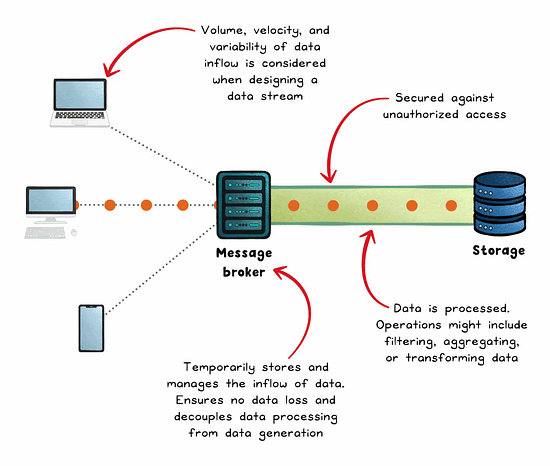Understanding Data Streams — The Solution to Handling Continuous Flows of Big Data
(4 Minutes) | Data Streams Demystified
Get our Architecture Patterns Playbook for FREE on newsletter signup:
Presented by Postman
Did you know there is a VS Code extension for Postman? It’s recently moved out of beta to general availability.
Demystifying Data Streams
We live in a time when everything is online and interconnected. From social media posts and sensor readings to real-time transaction logs, modern systems are inundated with information at a scale and speed previously unimagined.
With this mountain of information, the challenge lies in managing it all.
Enter the world of data streams—a brilliant solution to tackle this very problem.
What Exactly Is a Data Stream?
A data stream is a sequence of data that is generated continuously and often at high velocity.
Rather than processing data as a static batch, streaming processes the data in real-time (or near-real-time), enabling applications to react swiftly to the incoming information.
Types of Data Streams
The landscape of data streams can be quite diverse. Some streams are never-ending (continuous data streams), always supplying apps with fresh data.
Others have a clear beginning and end (bounded data streams), often originating from specific datasets.
There are also differences in how organized this data is.
While some streams are structured and may follow a schema, similar to database tables (structured data streams).
Others are more free-form, stemming from sources like text files or media content (unstructured data streams).
Lastly, there’s the factor of plurality.
Single-source streams come from a single data source, whilst multi-source streams mix and merge data from multiple sources.
As you’ve probably guessed, multi-source streams are more complex to work with but provide much richer insights.
Implementing a Data Stream
To implement a data stream it’s key to understand the volume, velocity, and variability of the data. The three Vs determine the demands of the streaming system.
Volume refers to the amount of data generated over a specific timeframe, dictating the storage and processing capacities needed.
Velocity touches on the speed at which data is produced and ingested into the system, affecting real-time processing capabilities.
Variability, on the other hand, delves into the inconsistencies or fluctuations in the data rate, which can pose challenges in terms of predictability and resource allocation.
With these factors in mind, appropriate selection of stream processing frameworks and other tools like data storage solutions can be made.
There are several other factors to keep in mind when building a streaming system.
First and foremost, the integrity of the data is vital; it should be consistent, accurate, and reliable.
Given the continuous flow of streams, inconsistencies can easily emerge, so proactive measures to prevent them are essential.
Additionally, security is paramount — don’t forget to implement security measures to ensure that the data remains protected from unauthorized access.
Best Practices
Data streams, like many other areas of tech, come with a set of guidelines to keep in mind.
First off, as the landscape of data continues to expand, it's vital to ensure our setups can horizontally scale.
In order to ensure no data is lost, make sure you implement fault tolerance.
Lastly, given how dynamic data can be, staying flexible is key.
Data streams might evolve due to new sources, differing formats, or varying data amounts. Anticipating these shifts helps systems stay robust and responsive.
As modern applications attempt to deal with a growing amount of data, strategies like data streams have become standout solutions. With their ability to manage real-time data efficiently, adapt to changing conditions, and provide invaluable insights, utilizing data streams has become, and will continue to be, essential for crafting robust and streamlined digital systems.
Subscribe to get simple-to-understand, visual, and engaging system design articles straight to your inbox:



